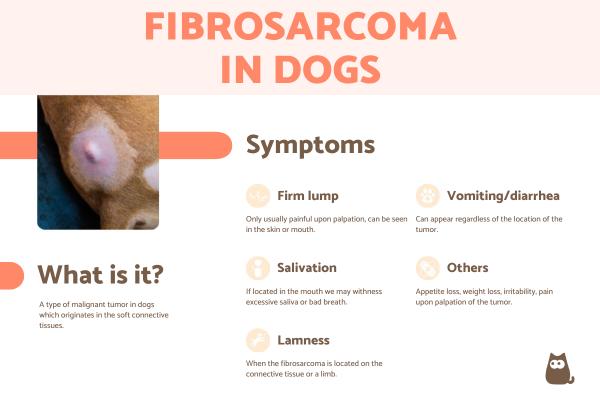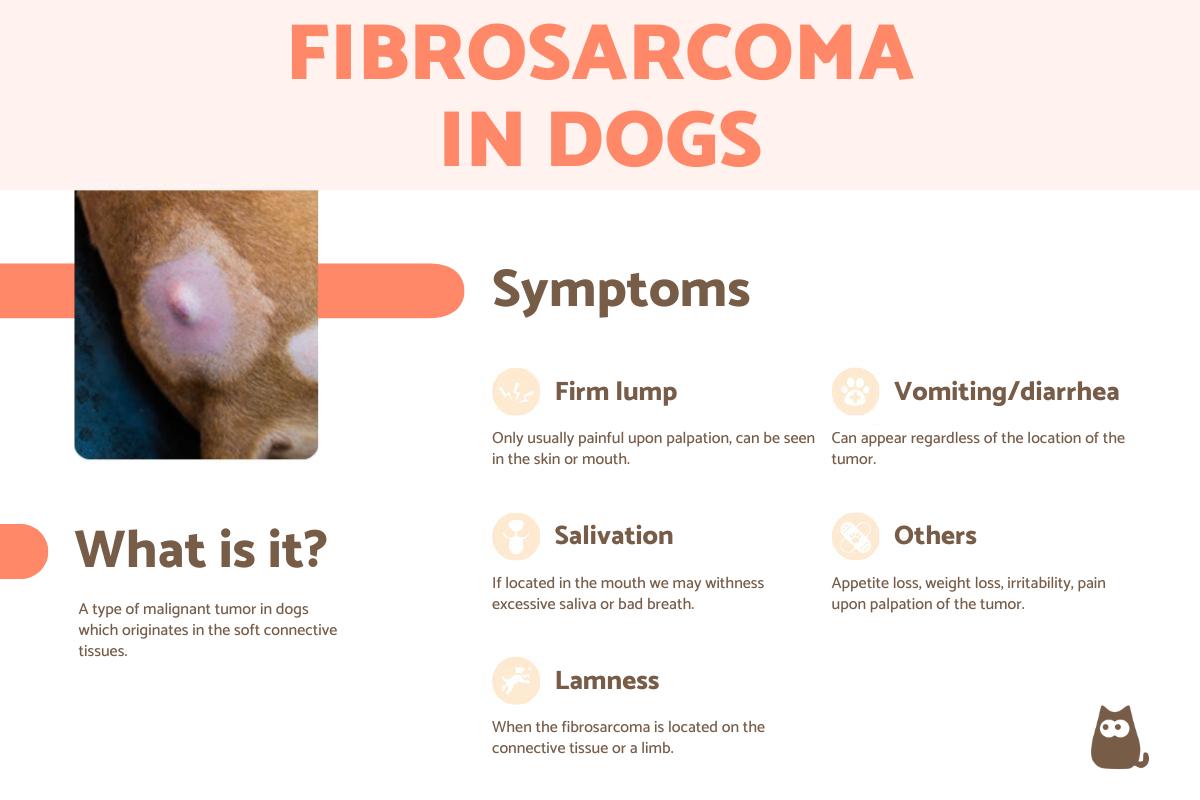Fibrosarcoma in Dogs - Causes and Treatment



See files for Dogs
Various types of tumors can appear on our dog's body. Although they can be completely benign, the fear of a malignant tumor is a call to action to achieve a quick diagnosis. This is the case with canine fibrosarcoma, a malignant tumor that affects the soft connective tissues of their body. It is a result of a proliferation of fibroblasts, spindle-shaped cells which are important in wound healing and are most found in connective tissues.
At AnimalWised, we learn more about the causes, symptoms and treatment of fibrosarcoma in dogs. We provide canine fibrosarcoma pictures, but it is important to know they cannot be diagnosed with sight alone. They need to be tested by a qualified veterinarian to achieve diagnosis.
What is fibrosarcoma in dogs?
Canine fibrosarcoma is a type of malignant tumor in dogs which originates in the soft connective tissues. They usually arise from a proliferation of the most common type of cell in connective tissues, fibroblasts. They can also be a result of other types of spindle-shaped cells in this connective tissue.
The function of connective tissues in dogs is to surround and support the other tissues of their bodies. For this reason, fibrosarcomas can be found in various places on a dog's body, although they most frequently appear in the skin, subcutaneous tissue or the oral cavity. Unlike certain other types of lumps in dogs, fibrosarcoma are hard to the touch.
Fibrosarcoma tumors can grow very slowly. However, they considered invasive, being able to infiltrate nearby tissues and worsening the problem. Although they do not usually spread to distant organs, metastasis may occur after surgical removal if even small remnants of the tumor are left. They usually appear as a firm mass under the skin which is not usually painful unless touched.
Discover more about the different types of tumors in dogs with our related article.
Symptoms of fibrosarcoma in dogs
Symptoms of fibrosarcoma in dogs can vary depending on the location, size and duration of time they have been present in the body. In general, the following are the symptoms that may indicate the presence of fibrosarcoma in dogs:
- A firm, painless lump on the skin or in the oral cavity that may grow slowly
- Excessive salivation, bad breath, bleeding and loss of teeth
- Pain and swelling in the mouth
- Lameness if located on a limb
- Swelling or changes in facial appearance when tumor is located in the head or neck
- Problems opening the mouth if the tumor invades the bone or surrounding tissue
- Weight loss, apathy, loss of appetite, irritability and pain upon palpation
- Vomiting and/or diarrhea
Discover another type of malignant tumor in dogs with our article on canine prostate cancer causes and treatment.

Causes of fibrosarcoma in dogs
There is no specific cause that explains why fibrosarcoma appears in dogs, but it is suspected that it may be both genetic and environmental, including the following:
- Breed predisposition: breeds such as the Golden Retriever, Labrador Retriever, and Doberman Pinscher are some breeds that may be at higher risk of developing fibrosarcoma.
- Genetic mutations: certain changes or mutations in the genes that control cell growth and proliferation may also predispose dogs to developing tumors such as fibrosarcoma. These mutations may be inherited or acquired during the dog's life.
- Age: although it can occur in dogs of any age, it is more common in older dogs.
- Inadequate diet and stress: can promote the development of this tumor. Learn about what type of diet dogs with cancer need in our related article.
- Alterations in the immune system: can also increase the risk of developing malignant tumors.
You can find out about another type of lump that appears in a dog's mouth with our article on epulis in dogs.
Diagnosis of fibrosarcoma in dogs
Diagnosis to determine whether your dog actually has fibrosarcoma is based on a clinical analysis. The veterinarian will examine the body for lumps or tumors, palpating to assess size, consistency and whether it is attached to underlying tissues. They will also likely evaluate the lymph nodes to detect possible signs of local spread.
If a tumor is suspected, the doctor will plan an imaging study such as an X-ray or ultrasound. This will assess whether the tumor is affecting the bone or if metastasis has occurred, as well as to analyze masses in soft tissues and guide the biopsy if necessary.
The definitive diagnosis of fibrosarcoma is based on a biopsy. This is where the cells of the tumor are extracted for later analysis in a laboratory. This can take time, depending on various factors.
Fibrosarcoma in dogs treatment
If you are wondering how to cure fibrosarcoma in dogs, you should know that the main treatment is surgery. The purpose of this intervention is to completely remove this tumor as soon as possible. In some cases, radiotherapy or chemotherapy may be used as a complementary treatment, especially in situations where the tumor cannot be completely removed. The following are the most common options for canine sarcoma treatment in these cases:
- Surgery: this is the treatment of choice and involves removing the tumor along with surrounding healthy tissue to prevent it from recurring. As these tumors are often quite invasive, more extensive surgery may be performed to ensure that all affected tissue has been removed.
- Radiotherapy: if complete removal of the tumor is not possible or if the surgical margins are compromised, radiotherapy may be used to treat the surgical area and destroy any residual tumor cells. In some cases, radiotherapy may be administered before surgery to try to reduce the size of the tumor and make it easier to remove.
- Amputation: this treatment is often useful in cases where the tumor is located in the extremities and cannot be completely removed.
- Chemotherapy: this is not always effective against fibrosarcomas, but if the tumor is inoperable or there is evidence of metastasis, it may be considered. It may also be used in conjunction with surgery and radiotherapy.
Other fibrosarcoma treatment options
Sometimes the tumor cannot be removed or the prognosis is poor. Due to the pain it causes, painkillers, anti-inflammatories and other drugs may be administered to maintain the dog's quality of life. If the cancer is extensive or has metastasized to vital organs, it is possible the dog may need palliative treatment or even euthanasia. Learn more about this process in our article discussing when to euthanize a dog with kidney failure.

Prognosis of fibrosarcoma in dogs
The success of treatment and the prognosis will depend on factors such as the location of the tumor, its size, the possibility of complete removal and whether there has been metastasis. Although surgical removal with wide margins of tissue removal is the ideal treatment, the tendency of fibrosarcoma to recur locally means that the prognosis may be guarded. Combining treatments can improve the dog's quality of life.
The prognosis of fibrosarcoma in dogs depends on the following:
- Surgical difficulty: if the tumor is located in areas where performing complete surgery is difficult, the prognosis may be worse. These areas include near joints or in the mouth in the case of oral fibrosarcoma.
- Size: smaller tumors located in one area have a better prognosis, especially if they can be completely removed. Larger tumors or those that have spread to other parts of the body usually have a poor prognosis.
- Surgical success: if the tumor can be removed without leaving any residual tumor cells, the prognosis is generally good. Tumors that cannot be completely removed have a greater tendency for it to recur and worsen the prognosis.
- Type of fibrosarcoma: low-grade fibrosarcoma in dogs is less aggressive, so it may also have a better prognosis as it spreads and grows less than high-grade fibrosarcoma.
- Other treatments: the effectiveness of treatments such as radiotherapy or chemotherapy can also help improve the prognosis, especially if surgery is not curative.
Discover other cancers which may require chemotherapy or radiotherapy with our article on the causes and treatment of mast cell tumors in dogs.
This article is purely informative. AnimalWised does not have the authority to prescribe any veterinary treatment or create a diagnosis. We invite you to take your pet to the veterinarian if they are suffering from any condition or pain.
If you want to read similar articles to Fibrosarcoma in Dogs - Causes and Treatment, we recommend you visit our Skin problems category.







